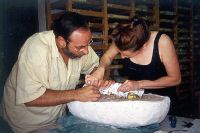The African wild cat and the domesticated house cat show similar morphological resemblances. Dr. Carlos Driscoll believes that these similarities are caused by the fact that cats invited themselves into our lives or rather that they underwent a process of what he calls "self-domestication". Driscoll has shown that most domestic cats are related to the descended from a Middle Eastern wildcat and became what we know today through a process of behavioral selection that begun12,000 years ago (1).
Excavation at the site of Shillourokambos in
 |
| Shillourokambos Cat Skeleton Cast |
References
1. http://www.smithsonianmag.com/history-archaeology/brief_cats.html?c=y&page=1
2. http://www2.cnrs.fr/en/292.htm


